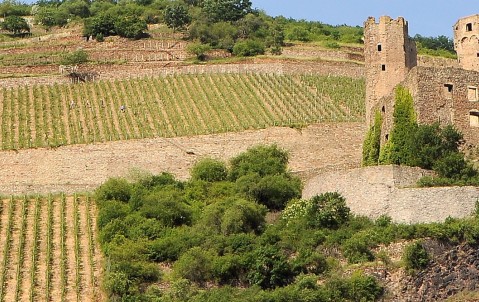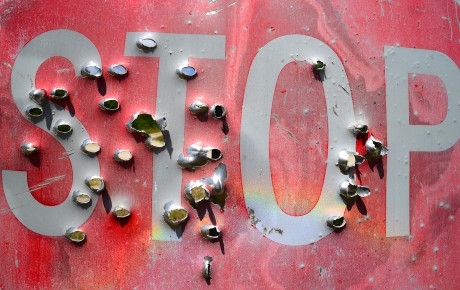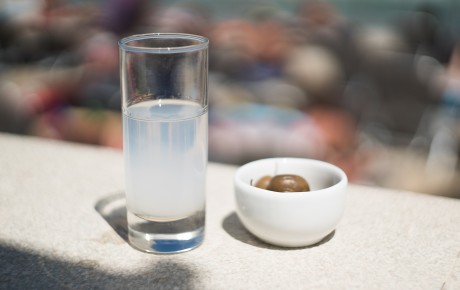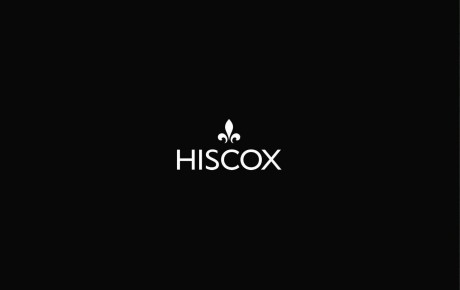
Blood red wine
Bobby Read salutes winemakers’ heroic achievements during times of conflict.
“One of the background pleasures of wine remains a distant awareness of history marching — or ambling steadily — to a different beat,” wrote the novelist and wine lover Julian Barnes, and it’s a sentiment with which I wholeheartedly agree.
Winegrowers work to their own calendar. Years are remembered by the trials and tribulations of nurturing the grapes and for the quality of the wines they produced, rather than momentous events in politics or sport. Thus, while Europe held its breath as British Prime Minister Neville Chamberlain flew to Munich to hold last-ditch talks with Hitler, the official history of Château Latour records: “The crisis was fortunately too brief to affect the picking.”
But there are times when winemaking and politics collide, particularly when vineyards unwillingly become battlegrounds. War becomes another adversity for winemakers to deal with along with rain, cold, pests and disease.
Champagne didn’t lose its fizz in Great War
In the First World War, the region famous for its sparkling wine became part of the frontline that stretched from the North Sea coast to the Swiss border. Rheims Cathedral was hit by German shellfire within weeks of the outbreak of war, and by 1918 90% of the city had been damaged.
1914 was one of the best vintages of the twentieth century – even though some grapes were picked early in case of a German counterattack – while 1915 and 1917 were also excellent years.
This account of the region’s war is from the Grande Marques and Maison du Champagne’s website:
“The vines in the region of Rheims were in the war zone. Criss-crossed with German and French trenches and riddled with craters from shells, cultivation had either stopped when the war began or been continued in the worst possible conditions. Cultivation carried on in Champagne’s other wine producing areas despite innumerable difficulties. Since all the men were in the army the population was made up of women, children, invalids, and the elderly; all displayed splendid courage in the face of adversity. There was not enough fertilizer or anti-parasite products, the horses had been requisitioned, the harvest houses were occupied by the troops, and artillery and aeroplane fire made the vines a dangerous place to work.”
But, in spite of all the turmoil, production continued. What was produced wasn’t good – it was wonderful. 1914 was one of the best vintages of the twentieth century – even though some grapes were picked early in case of a German counterattack after the French were victorious at the Battle of the Marne – while 1915 and 1917 were also excellent years.
Where there’s a will, there’s a way
Adversity also breeds ingenuity. There are many tales of how in the Second World War the French hid their best wines behind newly-built brick walls and artfully placed cobwebs over bottles of newer, inferior wines to make them look more alluring to the German invaders.
But a bigger problem was producing new wine. Apart from a lack of manpower – women not only harvested the grapes but also often crafted the wines – winemakers suffered an acute lack of pesticides. The Germans requisitioned France’s supply of copper, which meant Bordeaux winemakers had no copper sulphate to spray on the vines to prevent mildew.
Syria’s only commercial winery, Château Bargylus – grown on the same slopes where the Ancient Romans made wine – has had to deal with the fallout from the country’s civil war.
At Château Latour, growers at first used ammonia-of-cellulose copper, permitted by the authorities since it required 90% less copper. Then, it used permanganate of potash, again with success, meaning that Latour's average production during the war years wasn’t that much lower than it had been during the 1930s.
Today, Syria’s only commercial winery, Château Bargylus – grown on the same slopes where the Ancient Romans made wine – has had to deal with the fallout from the country’s civil war. Since the conflict broke out, grapes from its vineyards are packed in ice at harvest time and taken by taxi to Lebanon where the Saadé brothers, the estate’s owners, decide whether they are ready to be picked. In 2014, two stray mortar shells pulverised 15 of its prized chardonnay plants, and bullet holes pockmarked fences as fighting took place within a few hundred metres of the estate. But, production continued and its wines are stocked at restaurants of Michelin-starred chefs such as Joel Robuchon, Marcus Wareing, Heston Blumenthal and Gordon Ramsay.
Musar musings
I recently tried the 2006 Château Musar – currently available from Majestic, Virgin Wines, the Wine Society and Waitrose for around £25 a bottle. It is a particularly pertinent wine for this column’s subject matter, because it is made in Lebanon, which was ravaged by a 15-year civil war and conflict with its neighbours. During that time, shells fell among the vines, Israeli tanks turned up at the winery and its wine cellar doubled as a bomb shelter. But in all those years, Musar missed only one vintage.
If you drink a Château Bargylus or Musar, or if you’re lucky enough a 1914 vintage Krug or Pol-Roger, you’ll have more than wine. You’ll taste defiance, freedom and a heroic battle against the odds.
2006 was a particularly bloody year in Lebanon, but the wine shows no trace of that strife. It is a classic Musar mix of Cabernet Sauvignon, Carignan and Cinsault, which are each vinified separately and then blended, in this case in 2009, before spending a year in French oak (more subtle, or less oaky, than US oak barrels, if that makes sense). This wine was originally scheduled to be released in 2013 but was held back until 2017.
I opened the bottle three or four hours before drinking it and carefully decanted it. It wasn’t as heavy as some previous Musar vintages that I have tried, but the hedgerow fruit was still fresh, not stewed, and the tannins had softened. It was delicious and could probably be aged further. The notes from my tasting of the second bottle, which followed on possibly too swiftly from the first, are somewhat hazier. I slept like a log that night, even if others reported that my snoring was of epic proportions.
If you drink a Château Bargylus or Musar, or if you’re lucky enough a 1914 vintage Krug or Pol-Roger, you’ll have more than wine. You’ll also taste defiance, freedom, and, above all, a heroic battle against the odds.
“Wine is above politics,” Serge Hochar, the man behind Château Musar said in 2012. “Wine is tolerance.” In these increasingly intemperate times I’ll drink to that.



